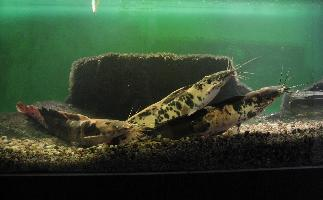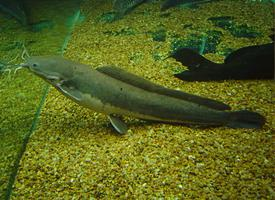
Súlyok és méretek
| Hossz | 55 cm |
|---|
Állatleírás
The Walking catfish, scientifically known as Clarias batrachus, is a unique and fascinating species of freshwater fish that has garnered attention due to its extraordinary ability to "walk" on land. Originating from Southeast Asia, this species is a member of the Clariidae family, known for their air-breathing capabilities which allow them to survive in environments with low oxygen levels. The Walking catfish is a robust and elongated fish, typically reaching lengths of up to 12 inches (30 cm) in its natural habitat, though some specimens have been reported to grow even larger in captivity.One of the most remarkable features of the Walking catfish is its skin color, which varies from a dark gray to a brownish hue, often speckled or mottled with darker patches that provide camouflage in the muddy waters of its natural environment. This species possesses a series of sensory barbels around its mouth, which serve as tactile organs to detect food in the murky waters where it dwells.
The anatomy of the Walking catfish is specially adapted for its terrestrial excursions. Unlike many other fish, it has a modified respiratory system that allows it to breathe atmospheric air. This adaptation is facilitated by a labyrinth organ, a structure that acts much like a lung, enabling the fish to absorb oxygen directly from the air. This remarkable adaptation allows the Walking catfish to survive out of water for significant periods, especially during the rainy season when it often migrates overland in search of new habitats or more abundant food sources.
The locomotion of the Walking catfish on land is an extraordinary sight. It propels itself forward using its pectoral fins, which are strong and spiky, pushing against the ground in a motion akin to walking. This unusual method of movement is not only a testament to the fish's adaptability but also a survival mechanism that allows it to traverse between water bodies that might be separated by dry land.
In its native habitat, the Walking catfish is an opportunistic feeder, consuming a diet that includes a wide variety of prey such as smaller fish, crustaceans, worms, and aquatic insects. Its ability to exploit different food sources, combined with its air-breathing capability, makes it a resilient and versatile species capable of thriving in diverse environments.
However, the adaptability and resilience of the Walking catfish have also led to its classification as an invasive species in several regions outside its native range, including parts of the United States. In these areas, the Walking catfish has been known to disrupt local ecosystems, outcompeting native species for resources and altering habitat structures.
Despite the challenges it poses as an invasive species, the Walking catfish remains a subject of fascination and study among scientists and aquarists alike. Its unique characteristics and behaviors provide valuable insights into evolutionary biology and the adaptive mechanisms of aquatic organisms, making Clarias batrachus a remarkable example of nature's ingenuity and versatility.
Hasonló állatok
Új állatfotók
Top 10 állat
- Dolphin gull (Leucophaeus scoresbii)
- Diana monkey (Cercopithecus diana)
- Moustached guenon (Cercopithecus cephus)
- Galápagos tortoise (Geochelone nigra complex)
- Japanese macaque (Macaca fuscata)
- Stone loach (Barbatula barbatula)
- Russian tortoise (Testudo horsfieldii)
- Greek tortoise (Testudo graeca)
- Common flying dragon (Draco volans)
- Vendace (Coregonus albula)
